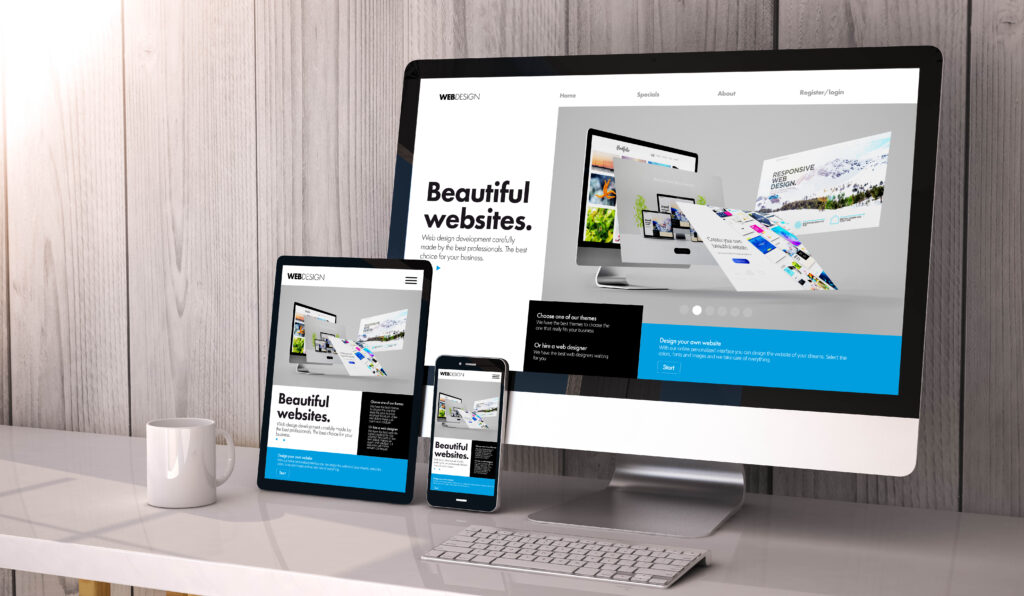Introduction
In today’s digital age, having a professional website is crucial, whether you’re an entrepreneur, artist, or small business owner. Fortunately, creating one doesn’t have to be a lengthy or complicated process. Thanks to advancements in technology, you can now design a stunning website in under an hour using a website builder. In fact, WordPress, one of the most popular content management systems, powers 43.3% of all websites on the internet.
The idea of building a website swiftly is appealing to many, especially those who may not have a technical background. Gone are the days when coding knowledge was a necessity. With a range of Website Builders available, each offering unique features and templates, anyone can build amazing websites with relative ease. Whether you’re creating an online portfolio, an eCommerce store, or a blog, these tools provide a user-friendly experience.
The primary step is selecting the right Website Builder for your needs. Different platforms offer various advantages, from advanced SEO functionalities to eCommerce capabilities. This choice will significantly impact your site’s performance and your ability to customise it to your liking.
Once you’ve selected a website builder, designing your site becomes straightforward. Website Builders have evolved to include drag-and-drop interfaces and customisable templates, eliminating the need for extensive design knowledge. This development ensures that even beginners can create professional websites efficiently. Additionally, website builders often come with built-in features that streamline the process, such as content management systems and analytics tools.
Templates play a vital role in the design process. They offer a starting point and can be tailored to match your brand’s aesthetic. This flexibility allows you to focus on personalising the details, ensuring that your site stands out.
Adding content is the next crucial step. The right combination of text, images, and media can make a significant difference in how your audience perceives your brand. Clear, concise content will engage visitors and encourage them to explore your site further.
With a solid design and engaging content, the final touches involve optimising for mobile devices and incorporating SEO strategies. This ensures that your site is accessible and visible to a broader audience.
By following these steps, you can harness the power of a Website Builder to create a professional, stunning website in less than an hour.
Select the Appropriate Website Builder
Choosing the right Website Builder is critical to your success. You need to consider features and user-friendliness. For those who want high customisation, complete control, scalability, and advanced SEO and eCommerce functionalities, WordPress is the best option . If you’re looking for a straightforward and quick design process, Squarespace provides over 160 templates designed for various types of websites . On the other hand, if you want a vast array of options, Wix offers over 900 customisable templates that allow you to create anything from eCommerce sites to blogs.
Design Your Website Layout
Designing your website layout begins with identifying the key pages and structuring the navigation. Consider the primary information you wish to convey and how users will interact with your site. Creating a sitemap or sketching a basic structure can be incredibly helpful in ensuring a logical flow.
For instance, most websites include essential pages such as Home, About, Services, Blog, and Contact. Depending on your specific needs, you may also include additional pages like Testimonials, Case Studies, or a Portfolio. Establish a clear hierarchy for your content, which will guide users naturally from one page to the next.
Navigation is crucial for user experience. A well-organised menu will make it easy for visitors to find what they’re looking for without getting lost. Place the primary menu at the top of your site or on a sidebar, and ensure it is easily accessible from all pages.
Next, focus on the layout of individual pages. Each page should have a consistent design that aligns with your brand’s aesthetic. Use headings, subheadings, and bullet points to break up text and make it more readable. White space is your friend; it keeps your pages from feeling cluttered and helps important elements stand out.
Incorporate calls to action (CTAs) strategically throughout your site. Whether you want visitors to contact you, sign up for a newsletter, or purchase a product, CTAs should be clear and compelling. Place them in prominent positions, such as at the end of blog posts, in the sidebar, or as buttons within the content.
Remember to include visual elements like images, videos, and graphics to make your site more engaging. These should complement your text and provide additional value to your visitors. Ensure that all visual content is high-quality and relevant to your message.
In summary, designing your website layout involves careful planning of both the overall structure and the specific elements on each page. By prioritising user experience and ensuring a clear, consistent design, you’ll create a site that is both functional and visually appealing.
Choose a Template
When selecting a template for your website, it’s essential to find one that complements your brand’s identity and meets your functional needs. WordPress offers an extensive range of options, with over 12,000 free themes and more than 59,000 plugins available. These templates can be easily customised to suit your specific style, making them an excellent choice for those looking to create unique and professional websites.
Each template serves as a foundation, providing a structured layout that can be tailored to fit your brand. Look for templates that are flexible and allow for easy modifications. This flexibility ensures you can adjust colours, fonts, and layouts to match your brand’s aesthetic. For instance, WordPress themes are highly customisable, and many come with built-in options that let you tweak various elements without needing any coding skills.
When browsing through available templates, consider the purpose of your website. Templates are often designed with specific industries or functionalities in mind. For instance, if you’re creating an online store, look for eCommerce templates with built-in shopping cart functionalities. On the other hand, if you’re building a portfolio, opt for a template that showcases visual content effectively.
Visual appeal is another crucial factor. High-quality images and a clean layout can significantly enhance the user experience. Choose a template that aligns with your brand’s visual identity and offers a professional look. Many website builders provide a preview feature, allowing you to see how your site will look with a particular template before making a final decision.
Templates also come with pre-designed sections for common website elements such as headers, footers, and sidebars. These sections can save you a considerable amount of time during the design process. Ensure the template you choose has these pre-built sections and that they can be customised to meet your specific needs.
Additionally, consider the template’s compatibility with plugins and extensions. For WordPress users, the availability of more than 59,000 plugins means you can add various functionalities to your site with ease.
Personalise Your Design
With your template selected, you can now personalise your design to reflect your brand’s uniqueness. Adjust colours, fonts, and images to align with your style. Website builders like WordPress offer a powerful block editor called Gutenberg, which allows users to build posts and pages using drag-and-drop blocks without any coding knowledge . Similarly, Squarespace’s drag-and-drop editor provides a smooth user experience , making it ideal for beginners to create professional websites with ease.
Personalisation extends beyond mere aesthetics. It’s about ensuring every element on your site conveys your brand message effectively. Begin by customising the header and footer to include your logo, navigation links, and contact information. These areas are prime real estate for showcasing your brand identity and making vital information easily accessible.
Typography plays a significant role in how your content is perceived. Choose fonts that are not only visually appealing but also readable. Many website builders offer extensive font libraries, allowing you to find the perfect match for your brand’s voice. Consistent use of typography across your site enhances coherence and professionalism.
Colour schemes are another critical aspect of personalisation. Select colours that resonate with your brand and evoke the desired emotions in your visitors. Most website builders allow you to customise colour palettes easily, ensuring a seamless integration of your brand colours throughout the site.
Images and multimedia content add a dynamic element to your website, making it more engaging. Use high-quality visuals that reflect your brand’s essence. Stock photos can be useful, but original images often have a more authentic impact. Additionally, consider incorporating videos, animations, and infographics to provide varied content that caters to different user preferences.
Interactive elements, such as buttons, forms, and social media integrations, can enhance user engagement. Ensure these elements are strategically placed and visually appealing. Customised buttons with clear calls to action can guide visitors towards desired actions, such as signing up for a newsletter or making a purchase.
Furthermore, consider the layout of your text and images. A well-organised layout with ample white space prevents your site from appearing cluttered and makes it easier for visitors to navigate and absorb information. Align text and images to create a harmonious flow, ensuring that each page is visually balanced.
Finally, don’t forget to test your personalised design on various devices and screen sizes.
Add Key Content
With your design established, the next step involves incorporating the essential content that will give your website its unique voice and character. Start by crafting compelling text that clearly communicates your brand’s message and values. Use concise, engaging language that captures your audience’s attention and encourages them to explore further.
Images play a significant role in enhancing your site’s visual appeal. High-quality photos can make a substantial difference in how your site is perceived. If possible, use original images that reflect your brand’s personality and ethos. While stock photos can be useful, they often lack the authenticity that original images provide.
In addition to static images, consider incorporating multimedia elements such as videos and audio clips. Videos can be particularly effective for demonstrating products, sharing customer testimonials, or providing tutorials. They add a dynamic component to your site, making it more engaging for visitors. Ensure any multimedia content is optimised for quick loading to avoid frustrating users with slow page speeds.
Organising your content is crucial for a seamless user experience. Break up large blocks of text with headings, subheadings, and bullet points to make it easier to read. This structure not only improves readability but also helps search engines better understand the content of your pages, which can enhance your SEO efforts.
Incorporate interactive elements to foster engagement. Features such as contact forms, comment sections, and social media integrations invite users to interact with your brand directly. These elements should be strategically placed to encourage user participation without overwhelming the visitor.
Including client testimonials or case studies can also be beneficial. These elements add credibility and build trust with your audience by showcasing real-life examples of how your products or services have made a positive impact. Place these strategically on your site to maximise their visibility.
When it comes to text, focus on clarity and precision. Your copy should be straightforward, avoiding jargon that could confuse your audience. Each section of text should serve a specific purpose, whether it’s to inform, persuade, or entertain. Use a consistent tone of voice that aligns with your brand’s identity to create a cohesive reading experience.
Don’t overlook the importance of call-to-action (CTA) buttons. These buttons guide visitors towards desired actions, such as signing up for a newsletter, making a purchase, or contacting you for more information. Ensure your CTAs are clear, compelling, and placed in prominent locations throughout your site.
Lastly, ensure all content is proofread and free from errors. Typos and grammatical mistakes can undermine your professionalism and deter potential customers. Take the time to review all text, images, and multimedia to ensure they meet your quality standards.
Optimise for Mobile Devices and SEO
With the increasing number of users accessing the internet via mobile devices, ensuring your website is mobile-friendly is paramount. Website Builders such as Squarespace offer responsive templates that automatically adjust to different screen sizes, providing an optimal viewing experience across all devices. This responsiveness enhances user experience and can positively impact your search engine rankings.
Alongside mobile optimisation, incorporating effective SEO techniques is essential for improving your website’s visibility on search engines. Builders like Squarespace provide built-in SEO tools, social media integrations, and detailed analytics to help you optimise your site. Similarly, Wix offers built-in SEO features such as structured data markup and XML sitemap generation to enhance your website’s reach.
To start with SEO, focus on researching and integrating relevant keywords into your content. These keywords should reflect the terms your target audience is likely to search for. Incorporate them naturally into headings, subheadings, and body text to ensure your content is both readable and search-engine friendly.
Meta tags, including title tags and meta descriptions, play a crucial role in how search engines interpret your site. They provide a summary of your page’s content and can significantly influence click-through rates from search engine results. Ensure each page has a unique title tag and meta description that includes relevant keywords.
Another critical aspect is the use of alt text for images. Alt text describes the content of an image, which helps search engines understand and index your visuals. This is especially important for users relying on screen readers, as it enhances accessibility.
Internal linking is also beneficial for SEO. Linking to other pages within your site helps search engines crawl your website more effectively and provides visitors with a more comprehensive user experience. Use descriptive anchor text for these links to give both users and search engines a clear idea of the linked content.
Lastly, consider the loading speed of your website. Slow-loading pages can frustrate users and lead to higher bounce rates. Compress images, enable browser caching, and minimise the use of heavy scripts to improve your site’s performance.
Review and Publish
With your website design complete, the next crucial step is to meticulously review it before making it live. Start by thoroughly checking each page for accuracy and consistency. Verify that all text is free from grammatical errors and typos, ensuring that your content is polished and professional.
Next, test all links within your site to confirm they direct visitors to the correct pages. Broken links can frustrate users and undermine the credibility of your site. Pay particular attention to external links, as these can change without notice.
Assess the functionality of interactive elements such as forms, buttons, and social media integrations. Ensure that forms capture the necessary information and submit it correctly. Buttons should lead to the intended actions, whether it’s navigating to another page, submitting a form, or sharing content on social media.
Evaluate the visual elements on your site. Check that all images, videos, and graphics are displayed correctly and are of high quality. Make sure that any multimedia content is optimised for quick loading to maintain a smooth user experience. Consistency in visual elements across different pages reinforces your brand’s identity.
Conduct a comprehensive review of your website’s mobile compatibility. Use various devices and screen sizes to ensure that your site looks and functions well on smartphones and tablets. Responsive design is critical in today’s digital landscape, where a significant portion of web traffic comes from mobile users.
Test the site’s performance in different web browsers, such as Chrome, Firefox, Safari, and Edge. Compatibility across browsers is essential for providing a seamless experience to all users, regardless of their browser preference.
Consider the accessibility of your site. Ensure that your content is easily navigable for users with disabilities. Use alt text for images, provide captions for videos, and ensure that your site is keyboard-friendly.
Review your website’s SEO settings to maximise visibility on search engines. Check that meta tags, including title tags and meta descriptions, are in place and correctly optimised with relevant keywords. Ensure that your site’s content is structured logically with appropriate headings and subheadings.
Finally, conduct a speed test to evaluate your site’s loading times. Optimise any elements that may be slowing down your site, such as large images or unnecessary plugins. A fast-loading site not only improves user experience but also positively impacts your search engine rankings.
Once you’re confident that everything is in order, you’re ready to make your website live. This step will allow your audience to access and engage with your content, marking the beginning of your online presence.
Conclusion
In today’s fast-paced digital world, having a professional website is more accessible than ever, thanks to the capabilities of modern Website Builders. These tools have revolutionised the way websites are created, making it possible for anyone, regardless of technical skill, to design a site that looks polished and functions seamlessly.
The journey begins with selecting a Website Builder that aligns with your specific needs. Whether you prioritise customisation, ease of use, or advanced functionalities, there’s a platform out there tailored to your requirements. The subsequent steps of choosing a template, designing the layout, and adding key content have been streamlined to be intuitive and user-friendly. The drag-and-drop interfaces, along with customisable templates, mean you no longer need to grapple with complex coding to achieve a professional finish.
Personalisation is where your website truly comes to life. Adjusting colours, fonts, and images to reflect your brand’s unique identity helps in creating a cohesive and engaging online presence. It’s essential to remember that personalisation goes beyond aesthetics; it’s about making every element of your site communicate your brand’s message effectively.
Adding key content such as compelling text, high-quality images, and engaging multimedia elements will ensure that your website captures and retains the attention of your audience. Interactive elements like forms and social media integrations further enhance user engagement, making your site more dynamic and appealing.
Optimising for mobile devices and incorporating SEO strategies are crucial steps in ensuring that your website reaches the widest possible audience. Responsive design and effective SEO practices not only improve user experience but also boost your site’s visibility in search engine results, driving more traffic to your site.
The final step before launching your website is a thorough review. Ensuring that all elements function correctly, content is error-free, and the site performs well across various devices and browsers is essential for a smooth user experience.
By following these steps, you can create a professional, visually appealing, and functional website in a remarkably short time. The ease and efficiency offered by modern Website Builders empower anyone to establish a robust online presence, contributing to their business success or personal brand growth.



